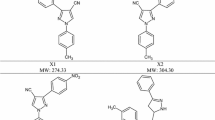Abstract
Tiopinac displayed marked anti-inflammatory activity when given p.o. in rat models of acute and chronic inflammation. It inhibited carrageenan-induced paw edema (40 x phenylbutazone), and cotton-pellet-induced granuloma (0.8 x indomethacin). In an 18-day test, tiopinac prevented the development of adjuvant-induced arthritis (10–15 x naproxen) and had similar activity versus pre-induced arthritis. Tiopinac exhibited antiphlogistic activity in adrenalectomized rats. It did not have corticosteroid activity. Depending upon the type of analgesic test used, the potency of tiopinac varied. When given p.o. it inhibited henylquinone-induced writhing in the mouse and rat (respectively 16 and 10 x aspirin). In contrast, tiopinac had ∼ 10 times the potency of indomethacin in increasing the pain threshold when yeast-inflamed paws were compressed. The pain threshold of the noninflamed paw was not increased. Tiopinac was highly active versus pain induced by flexing the adjuvant arthritic-inflamed paw (≥1000 x aspirin). It was inactive in the mouse hotplate test in which opiate-like agents are active. Tiopinac, p.o., lowered yeast-induced pyrexia (130 x aspirin). Tiopinac did not have significant cardiovascular or CNS activity. Whereas the ED50 versus adjuvant arthritis in rats was 0.1 mg/kg/day p.o., rats tolerated up to 20 mg/kg/day p.o. in the 8-day cotton-pellet test. Lack of anorexia and emesis in dogs with up to 30 mg/kg p.o. and mild oral activity in producing gastric erosion in acute and subacute studies in rats suggests that tiopinac may have relatively little gastrointestinal irritating activity.
Similar content being viewed by others
References
A.P. Roszkowski, W.H. Rooks II, A.J. Tomolonis andL.M. Miller,Anti-inflammatory and Analgetic Properties of d-2-(6′-Methoxy-2′-naphthyl)-propionic Acid (Naproxen), J. Pharmac. exp. Ther.179, 114–123 (1971).
J. Ackrell, Y. Antonio, F. Franco, R. Landeros, A. Leon, J.M. Muchowski, M.L. Maddox, P.H. Nelson, W.H. Rooks, A.P. Roszkowski andM.B. Wallach,Synthesis and Anti-inflammatory Activity of 6,11-Dihydro-11-oxodibenzo [b,e] thiepinalkonoic Acids and Related Compounds, J. Med Chem.21, 1035–1044 (1978).
C.A. Winter, E.A. Risley andG.W. Nuss,Carrageenin-induced Edema in Hind Paw of the Rat as an Assay for Anti-inflammatory Drugs, Proc. Soc. Exp. Biol. Med.111, 544–547 (1962).
R. Meier, W. Schuler andP. Desaulles,Zur Frage des Mechanismus der Hemmung des Bindegewebswachstums durch Cortisone, Experientia (Basel)6, 469–471 (1950).
C.M. Pearson,Development of Arthritis Periarthritis and Periostitis in Rats Given Adjuvants, Proc. Soc. Exp. Biol. Med.91, 95–101 (1956).
L.C. Hendershot andJ. Forsaith,Antagonism of the Frequency of Phenylquinone-induced Writhing in the Mouse by Weak Analgesics and Nonanalgesics, J. Pharmac. exp. Ther.125, 237–240 (1959).
L.O. Randall andJ.J. Selitto,A Method for Measurement of Analgesic Activity of Inflamed Tissue, Arch. Int. Pharmacodyn. Ther.111, 409–419 (1957).
S. Kazuna andK. Kawai,Evaluation of Analgesic Agents in Rats With Adjuvant Arthritis, Chem. Pharm. Bull.23, 1184–1191 (1975).
P.A.J. Janssen andP. Jageneau,A New Series of Potent Analgesics: dextro 2:2-Diphenyl-3-methyl-4-morpholinobutyrylpyrrolidine and Related Amides. Part 1. Chemical Structure in Pharmacological Activity, J. Pharm. Pharmacol.9, 381–400 (1957).
J.T. Hitchens, S. Goldstein, A. Sambuca andI. Shemano,Ulcerogenic Effects of Nonsteroidal Anti-inflammatory Agents in Rats, Pharmacologist9, 242 (1967).
J.T. Litchfield Jr. andF. Wilcoxon,A Simplified Method of Evaluating Dose-effect Experiments, J. Pharmac. exp. Ther.96, 99–113 (1949).
S. Irwin,Drug Screening and Evaluation of New Compounds in Animals, in:Animal and Clinical Pharmacologic Techniques in Drug Evaluation (Eds. J.H. Nodine and P.E. Siegler; Year Book Medical Publishers, Chicago 1964).
E.A. Swinyard, W.C. Brown andL.S. Goodman,Comparative Assays of Antiepileptic Drugs in Mice and Rats, J. Pharmac. exp. Ther.106, 319–330 (1952).
H.J. Ketteler, D.L. Braun andA. Kandel,Assay of Appetite Control Drugs in Mice, Pharmacologist9, 244 (1967).
D.J. Finney,Statistical Methods in Biological Assay (Hafner Publishing Co., New York 1964).
C.J.E. Niemegeers, F.M. Lenaerts andP.A.J. Janssen,The Antipyretic Effect of Suprofen in Rats With Yeast-induced fever, Arzeim. Forsch.25, 1519–1524 (1975).
J.R. Vane,Inhibition of Prostaglandin Synthesis as a Mechanism of Action for Aspirin Like Drugs, Nature New Biol.231, 232–235 (1971).
R.J. Flower,Drugs Which Inhibit Prostaglandin Biosynthesis, Pharmacol. Revs.26, 33–67 (1974).
R.C. Chin andY. Hodges,Inhibitory Effect of 6,11-Dihydrodibenzo-[b.e.]-thiepin-11-one-3-acetic Acid (DBTA) on the Production of Prostaglandin E (PGE) and Bone Resorption Stimulating (BRS) Activity in Human Rheumatoid Synovial Tissue (RAST), Fed. Proc.37, 662 (1978).
D.V.K. Murthy andM. Kruseman-Aretz,Inhibition of Prostaglandin (PG) Synthase by 6,11-Dihydrodibenzo-[b.e.]-thiepin-11-one-acetic Acid (DBTA), a Novel Nonsteroidal Anti-inflammatory Agent (NSAA), Fed. Proc.37, 662 (1978).
Author information
Authors and Affiliations
Additional information
A preliminary presentation of this study was delivered at the Federation of American Societies of Experimental Biology Meeting, Atlantic City, N.J., 1978 (Fed. Proc.37, 662 (1978).
Rights and permissions
About this article
Cite this article
Rooks, W.H., Tomolonis, A.J., Maloney, P.J. et al. The anti-inflammatory and analgesic profile of 6,11-dihydrodibenzo-[b.e.]-thiepin-11-one-3-acetic acid (Tiopinac). Agents and Actions 10, 266–273 (1980). https://doi.org/10.1007/BF02025946
Received:
Issue Date:
DOI: https://doi.org/10.1007/BF02025946




